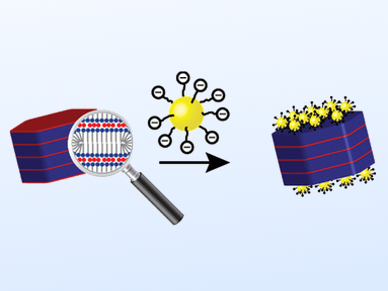Self-assembly is a popular, bio-inspired, bottom-up strategy to prepare large molecular structures that can reach dimensions in the order of micrometers. The products of these techniques could have applications in the fields of nanodevices, drug delivery, and catalysis.
Leonard J. Prins, University of Padova, Italy, and colleagues have developed a finely controlled stepwise self-assembly process leading to 3D hybrid organic/inorganic species of extraordinarily large dimensions in water. Each step in the process relies exclusively on noncovalent interactions between the components.
The assembly starts with the formation of a complex between an amphiphilic molecule bearing a triazacyclononane (TACN) head group and Zn2+ ions. This results in the formation of disk-like micellar structures (pictured dark blue). These discs undergo a stacking process induced by the addition of adenosine triphosphate (ATP, pictured red). The stacked disks form large hexagonal prisms with dimensions of 2·105 nm2. The prisms can be decorated with gold nanoparticles (pictured yellow) through a final self-assembly process activated by an enzyme. The resulting prisms could be used for sensing and catalysis applications.
- Stepwise Hierarchical Self-Assembly of Supramolecular Amphiphiles into Higher-Order Three-Dimensional Nanostructures,
Flavio della Sala, Wessel Verbeet, Simone Silvestrini, Ilaria Fortunati, Camilla Ferrante, Leonard J. Prins,
ChemNanoMat 2018.
https://doi.org/10.1002/cnma.201800097




